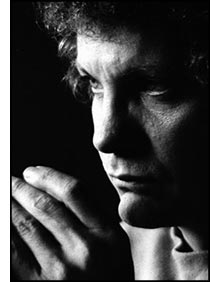 Mentors: We all need them and I had some of the best…
Mentors: We all need them and I had some of the best…
Starting out as a guerrilla filmmaker in Hollywood in the 1970’s my only filmmaking mentors were the ones that I found up on the big screen. I wasn’t born into Tinsel Town Royalty nor did I have any connection in The Film Biz… instead I simply went to the movies. Any and all movies and eventually I discovered that my preference was for Foreign Films, especially European Art Films…
I idolized the documentary-like prowess of Jean-Luc Godard and Raoul Coutard in BREATHLESS. I was amazed by the brilliant minimalist accomplishments of Ingmar Bergman and Sven Nykvist in PERSONA and I was astounded at Bernardo Bertolucci and Vittorio Storaro’s dazzling artistry in THE COMFORMIST.
I went to these “Art Films” over and over again, usually at the Los Feliz Theater on Vermont Avenue, basking in the glow of the big screen and hoping to become illuminated by these artists’ illumination. I also kept up on Hollywood films by going to double bills at the 24 hour Pix Theater on Hollywood Boulevard, Underground films at the Cinema Theater on Western Avenue, and even “X-Rated For Violence” Japanese Samurai Films at the Toho Theater on La Brea Avenue.
Soon I began to find work and was able to put what I’d learned at the movies into practice, when I was hired as a “Cinematographer/Editor”. This meant that I photographed the film, then edited what I had shot. This turned out to be an excellent choice because as the Editor, I immediately saw all of my glaring mistakes as the Cinematographer. I could easily spot them as they raced through the old upright Movieola at 24 frames per second and then I would set about correcting them as quickly as possible.
As the gods of fate and destiny would have it, it was there in the confines of the editing room, facing an old upright Movieola that I would have a life changing epiphany regarding film lighting and the some of the best mentoring possible on the planet from the maestro of the Cinema himself, Stanley Kubrick.
How did this amazing, enlightening experience occur? Simply out of necessity. Back in the day, whenever you prepared your sound tracks for the final sound mix, you had to place each actor’s performance onto a separate 1000-foot reel so that the sound mixer would be able to control the levels.
During this process, between the sections of 35mm sound track containing the actor’s performances, you need to place “fill leader” which usually consisted of unused prints of 35mm films. I happened to be running out of fill leader and called our lab, which was MGM, and asked them to send me out another box. When it arrived I was astounded, amazed and overjoyed to find that the lab had sent me a 35mm print of Stanley Kubrick’s A CLOCKWORK ORANGE, with French sub-titles.
I had been an adoring fan of this groundbreaking film for several years and to this day, I still have ticket # 001 from the Filmex Screening of this masterpiece when it premiered on Hollywood Boulevard in 1971. I immediately took all of my work off of the old upright Movieola and put Mr. Kubrick’s work onto it, then I spent several hours running the maestro’s work over and over and over….
Remember this was “back in the day” during the 1970’s. There were No VHS tapes, there were No DVD’s, the only way to study a film was to go to a screening and then the projectionist could not and would not replay your favorite scenes or reels… So you can imagine my elation at finally being able to study Mr. Kubrick’s work up close and personal. I felt that by studying this film, the masterful Mr. Kubrick was actually mentoring me.
There I was running my favorite scenes from A CLOCKWORK ORANGE… over and over and over… When I came to the famous scene where Little Alex kills the Cat Lady with the sculpture of the giant phallus, I was running it forward and back… forward and back… forward and back… Suddenly I stopped: WAIT A F#@!ING MINUTE!!!
I could see that Mr. Kubrick had shot this scene with an 18mm lens on his hand held Arriflex camera, while he followed Little Alex and the Cat Lady chasing each other around the room… I could also plainly see all four walls, the floor and the ceiling…
All four walls the floor and the ceiling…
And there were: NO MOVIE LIGHTS!!!
I was astounded! This was no Roger Corman film, this was no student film, this was a Big Studio, Warner Brothers, Stanley Kubrick production that had been nominated for four (4) Academy Awards… And there were: NO MOVIE LIGHTS!!!
Immediately I stopped on certain frames to study and determine the actual practical lighting that Mr. Kubrick had designed for this scene. He had simply placed several “light sculptures” each containing what looked like a dozen 150-watt bulbs around the room and his scene was lit.
Finally, I went through A CLOCKWORK ORANGE scene by scene and also began to look very closely at the rest of Mr. Kubrick’s work and discovered that time and time again he had used this same technique of: “Building The Lighting Into The Sets.” The War Room in DR. STANGELOVE… The circular space ship in 2001… The candlelit rooms in BARRY LYNDON…